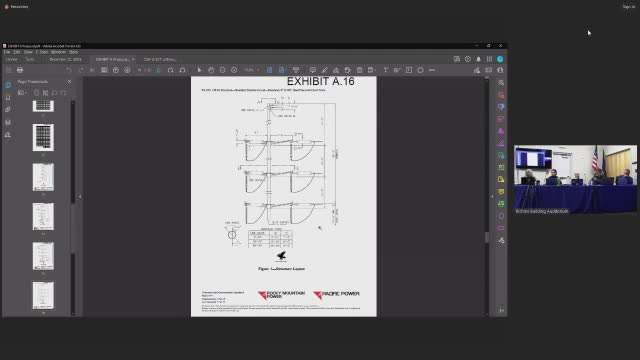Commissioners address noise concerns and restoration plans for new transmission line project
September 12, 2023 | Snyderville Basin Planning Commission, Snyderville, Summit County, Utah
This article was created by AI summarizing key points discussed. AI makes mistakes, so for full details and context, please refer to the video of the full meeting. Please report any errors so we can fix them. Report an error »

In a recent meeting of the Summit County Snyderville Basin Planning Commission, discussions centered around the implications of a new transmission line project, raising concerns about noise, environmental impact, and restoration efforts. As commissioners gathered under the bright lights of the meeting room, the atmosphere was charged with a mix of anticipation and apprehension regarding the changes ahead.
One of the key topics was the potential noise generated by the new transmission lines, which are set to increase in voltage from 69 kilovolts to a capacity of 138 kilovolts. Residents expressed worries about whether this upgrade would lead to a louder environment. However, experts assured the commission that the noise levels would remain equivalent to what is currently experienced, despite the higher voltage. The discussion highlighted the complexities of sound generation from power lines, particularly in different seasons and areas, with winter months potentially amplifying noise due to increased demand.
Commissioner Diane raised an important point regarding the physical dimensions of the new poles. Contrary to expectations of significantly larger structures, it was revealed that the base diameter of the new poles would not differ substantially from the existing ones, with some poles remaining similar in size while others may be larger. This clarification aimed to alleviate concerns about the visual impact of the new infrastructure.
Another critical aspect of the meeting involved the restoration of disturbed areas following construction. Commissioner Thomas emphasized the need for a robust bond to ensure that vegetation and trails affected by the project would be adequately restored. He expressed concerns based on previous experiences with restoration efforts, noting that while some areas had been well remediated, others had not met expectations. The commission discussed the importance of establishing clear guidelines and accountability for restoration, particularly in neighborhoods and open spaces that are heavily used by the community.
As the meeting progressed, the commissioners underscored their commitment to balancing the needs of infrastructure development with environmental stewardship. They acknowledged the challenges of ensuring that restoration efforts are timely and effective, particularly in areas frequented by residents for recreation. The dialogue reflected a broader concern for maintaining the natural beauty and accessibility of the region while accommodating necessary utility upgrades.
In conclusion, the Snyderville Basin Planning Commission's meeting highlighted the intricate interplay between community needs, environmental impact, and infrastructure development. As the project moves forward, the commission's vigilance in overseeing restoration efforts will be crucial in ensuring that the community's landscape remains vibrant and accessible for all. The discussions set the stage for ongoing engagement between residents, planners, and utility providers, emphasizing the importance of collaboration in shaping the future of Summit County.
One of the key topics was the potential noise generated by the new transmission lines, which are set to increase in voltage from 69 kilovolts to a capacity of 138 kilovolts. Residents expressed worries about whether this upgrade would lead to a louder environment. However, experts assured the commission that the noise levels would remain equivalent to what is currently experienced, despite the higher voltage. The discussion highlighted the complexities of sound generation from power lines, particularly in different seasons and areas, with winter months potentially amplifying noise due to increased demand.
Commissioner Diane raised an important point regarding the physical dimensions of the new poles. Contrary to expectations of significantly larger structures, it was revealed that the base diameter of the new poles would not differ substantially from the existing ones, with some poles remaining similar in size while others may be larger. This clarification aimed to alleviate concerns about the visual impact of the new infrastructure.
Another critical aspect of the meeting involved the restoration of disturbed areas following construction. Commissioner Thomas emphasized the need for a robust bond to ensure that vegetation and trails affected by the project would be adequately restored. He expressed concerns based on previous experiences with restoration efforts, noting that while some areas had been well remediated, others had not met expectations. The commission discussed the importance of establishing clear guidelines and accountability for restoration, particularly in neighborhoods and open spaces that are heavily used by the community.
As the meeting progressed, the commissioners underscored their commitment to balancing the needs of infrastructure development with environmental stewardship. They acknowledged the challenges of ensuring that restoration efforts are timely and effective, particularly in areas frequented by residents for recreation. The dialogue reflected a broader concern for maintaining the natural beauty and accessibility of the region while accommodating necessary utility upgrades.
In conclusion, the Snyderville Basin Planning Commission's meeting highlighted the intricate interplay between community needs, environmental impact, and infrastructure development. As the project moves forward, the commission's vigilance in overseeing restoration efforts will be crucial in ensuring that the community's landscape remains vibrant and accessible for all. The discussions set the stage for ongoing engagement between residents, planners, and utility providers, emphasizing the importance of collaboration in shaping the future of Summit County.
Don't Miss a Word: See the Full Meeting!
Go beyond summaries. Unlock every video, transcript, and key insight with a Founder Membership.
✓
Get instant access to full meeting videos
✓
Search and clip any phrase from complete transcripts
✓
Receive AI-powered summaries & custom alerts
✓
Enjoy lifetime, unrestricted access to government data
30-day money-back guarantee


